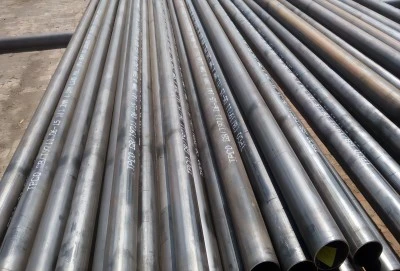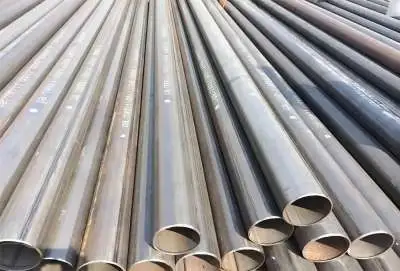In the world of long-distance pipeline systems, high frequency welded (HFW) pipes have emerged as a game-changer. These pipes, manufactured using advanced welding techniques, offer numerous advantages that make them the preferred choice for oil and gas transportation over vast distances. This article delves into the benefits of HFW pipes and explores why they've become essential in modern pipeline infrastructure.
|
|
|
What Are the Advantages of High Frequency Welded Pipes in Long-Distance Pipelines?
High frequency welded pipes bring a host of benefits to long-distance pipeline projects, making them an increasingly popular choice among engineers and project managers. Let's explore some of the key advantages:
1. Superior Weld Quality
One of the primary advantages of HFW pipes is the exceptional quality of their welds. The high-frequency welding process creates a strong, uniform bond along the entire length of the pipe. This results in a seamless weld that is often indistinguishable from the base metal, providing excellent structural integrity. The high-quality weld reduces the risk of leaks and failures, which is crucial for long-distance pipelines carrying valuable and potentially hazardous materials like oil and gas.
2. Improved Corrosion Resistance
HFW pipes exhibit enhanced corrosion resistance compared to traditional welded pipes. The high-frequency welding process minimizes the heat-affected zone (HAZ), reducing the likelihood of localized corrosion at the weld seam. This improved corrosion resistance is particularly beneficial for long-distance pipelines that may be exposed to varying environmental conditions and corrosive substances over their operational lifetime.
3. Consistent Wall Thickness
High frequency welding allows for precise control over the pipe's wall thickness. This consistency is crucial for maintaining uniform pressure distribution and flow characteristics throughout the pipeline. In long-distance applications, even minor variations in wall thickness can lead to significant inefficiencies or potential weak points. HFW pipes help mitigate these risks by ensuring a more consistent and reliable pipeline structure.
How Does High Frequency Welding Improve Pipeline Performance Over Long Distances?
The high frequency welding process contributes to improved pipeline performance in several ways:
1. Enhanced Mechanical Properties
HFW pipes often exhibit superior mechanical properties compared to other welding methods. The high-frequency welding process can actually improve the strength of the weld area, making it as strong as or stronger than the base metal. This enhanced strength is crucial for long-distance pipelines that must withstand high internal pressures and external forces over extended periods.
2. Reduced Friction and Improved Flow
The smooth internal surface of HFW pipes, resulting from the precise welding process, contributes to reduced friction and improved flow characteristics. In long-distance pipelines, even small reductions in friction can lead to significant improvements in efficiency and throughput. This smooth surface also minimizes the risk of material buildup inside the pipe, which could otherwise lead to reduced flow rates or increased maintenance requirements over time.
3. Increased Fatigue Resistance
Long-distance pipelines are subject to various cyclic loads, including pressure fluctuations and temperature changes. HFW pipes demonstrate excellent fatigue resistance, which is crucial for maintaining the integrity of the pipeline over its operational lifespan. The high-quality weld and consistent material properties contribute to this improved fatigue performance, reducing the risk of failures due to repeated stress cycles.
Why Are HFW Pipes Preferred for Oil and Gas Transportation Over Long Distances?
The oil and gas industry has increasingly turned to HFW pipes for long-distance transportation due to several key factors:
1. Cost-Effectiveness
While the initial cost of HFW pipes may be higher than some alternatives, their long-term cost-effectiveness makes them an attractive option for oil and gas transportation. The superior durability and reduced maintenance requirements of HFW pipes can lead to significant cost savings over the life of the pipeline. Additionally, the efficient production process of HFW pipes allows for faster project completion times, further contributing to overall cost savings.
2. Reliability and Safety
In the oil and gas industry, reliability and safety are paramount. HFW pipes offer a level of dependability that is crucial for transporting these valuable and potentially hazardous materials over long distances. The high-quality welds, consistent wall thickness, and improved corrosion resistance all contribute to a safer, more reliable pipeline system. This reliability not only protects the environment and nearby communities but also ensures consistent supply and reduces the risk of costly shutdowns.
3. Versatility and Adaptability
HFW pipes can be manufactured in a wide range of sizes and grades, making them suitable for various oil and gas transportation needs. This versatility allows pipeline designers to optimize their systems for specific requirements, whether it's high-pressure natural gas transmission or heavy crude oil transport. The adaptability of HFW pipes also makes them suitable for different terrains and environmental conditions, a crucial factor in long-distance pipeline projects that may traverse diverse landscapes.
Contact Longma
High frequency welded pipes have revolutionized long-distance pipeline systems, particularly in the oil and gas industry. Their superior weld quality, improved corrosion resistance, and consistent wall thickness contribute to enhanced performance and reliability over extended distances. The benefits of HFW pipes, including improved flow characteristics, increased fatigue resistance, and cost-effectiveness, make them an ideal choice for modern pipeline infrastructure.
As the demand for efficient and reliable long-distance transportation of oil and gas continues to grow, the role of high frequency pipes is likely to become even more significant. Their ability to meet the stringent requirements of the industry while offering long-term cost savings and improved safety makes them an invaluable asset in the development of global energy infrastructure.
If you're considering a long-distance pipeline project and want to explore the benefits of high frequency welded pipes, don't hesitate to reach out to the experts at Longma Group. Our team of specialists can provide detailed information on our range of HFW pipes and help you determine the best solution for your specific needs. Contact us today at info@longma-group.com to learn more about how our high-quality HFW pipes can enhance the performance and reliability of your long-distance pipeline system.














